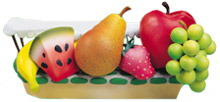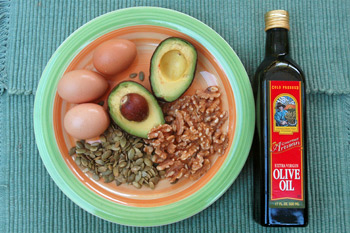Nutrition, Food Groups and Balanced Diet
Contents
Nutrition
<kaltura-widget kalturaid='292683' size='M' align='R'/>
This is an exciting topic. It covers everything to do with what we eat, when we eat, how much we eat, how meals are prepared and making choices that will help us look good and feel good. Eating the right foods and responding to what our body needs is called having a balanced diet.
Balanced diet
A healthy diet is a diet that does not contain excessive quantities of fat, sugar or salt, and that has contains essential nutrients. These nutrients provide enough energy, growth and repair elements, vitamins and minerals for the body to function at peak efficiency.
Nutrients
There are six main classes of nutrients that the body needs:
- carbohydrates
- proteins
- fats
- vitamins
- minerals
- water
It is important to consume these six nutrients on a daily basis to build and maintain healthy bodily function.Poor health can be caused by an imbalance of nutrients, either an excess or deficiency, which, in turn, affects bodily functions.
Food groups
Foods are classified in groups, some classifications divide them into five or six groups. The main groups are:
- Fruits and vegetables
- Grains, bread, cereals and pasta
- Milk, yoghurt and cheese
- Fish, poultry, meat, eggs and nuts
- Fats and oils
| Food group | My favourite foods |
|---|---|
| Fruits |
|
| Vegetables |
|
| Grains, cereals, bread, pasta |
|
| Fish, poultry, meat, beans |
|
| Milk, yoghurt and cheese |
|
Fruits and vegetables
The consensus is that you have to eat at least five portions of fruit and vegetables per day. A portion is approximately 80g (e.g. 1 medium apple), 1/2 a cup, 150 ml of fruit juice.
Fruits
Fruits can be enjoyed a number of ways: fresh, canned, frozen, dried, whole, cut-up, or pureed. Go easy on the fruit juices, though; they contain a lot of natural sugars. Besides the standards such as apples, bananas, oranges, peaches, pears and plums, try mangoes, blackberries, papayas, hybrid melons and avocados.
How much should you eat? Most of us should EAT MORE FRUITS!
Healthy eating tips
- Choose fruit as a snack
- Add dried or fresh fruit to breakfast cereals
- Choose a wide variety of fruits
Vegetables Go for the brights: the deeper the colour, the greater the concentration of vitamins, minerals and antioxidants. Dark green and orange vegetables, from broccoli, watercress to squash and sweet potatoes, are several excellent choices. Dried beans and peas, such as black beans and kidney beans, count in the vegetable category as well as the meat and beans group. 100 percent vegetable juice counts, too.
How much should you eat? Most of us should EAT MORE VEGETABLES!
Healthy eating tips
- Choose chopped vegetables as a snack
- Have a salad with sandwiches or with pizza
- Add vegetables to casseroles and stews and fruit to desserts
- Choose a wide variety of vegetables to eat
Grains, bread, cereal, pasta
- This group should provide 6 ounce-equivalents (1 ounce-equivalent means 1 serving), half of which should be whole grains.
Whole grains include whole wheat, brown rice, oatmeal, whole grain barley, millet, and popcorn. Whole grains are more nutritious than refined grains which include many breads, pastas, breakfast cereals and tortillas.
How much should you eat? Most of us should EAT MORE!
Base a third of your food intake on foods from this group, aiming to include at least one food from this group at each meal, e.g. potatoes with fish and vegetables, a chicken salad sandwich, stir-fried vegetables with rice, or porridge oats for breakfast.
Potatoes, yams, plantains and sweet potato fall into this group, rather than fruit and vegetables, because they contain starchy carbohydrates.
Sugar is a simple form of carbohydrate. It adds flavour and sweetness to foods, but frequent consumption of sugar-containing foods and drinks is associated with an increased tendency towards tooth decay.
Healthy eating tips
- Base your meals around foods from this group
- Eat wholegrain or whole meal breads, pastas and cereals as well as white choices
- Choose low fat oven chips rather than fried chips (oven chips fall into this food group but fried chips don’t)
- Eating more foods from this group will help to reduce the proportion of fat and increase the amount of fibre in the diet
- Avoid frying or adding too much fat to these foods
Fish, meat, poultry,egss nuts and beans
- This group should provide 5.5 ounce-equivalents or servings.
This group includes fish, poultry, eggs, beans, peas, nuts and seeds. Harvard Health suggests avoiding red meats because they contain a lot of saturated fat.
How much should you eat? EAT MODERATE AMOUNTS
Choose lower fat versions whenever you can. Some meat products, e.g. beef burgers and sausages, can be high in fat. Trim visible fat off meat where possible. It is recommended that you eat two portions of fish each week, one of which should be an oily fish (e.g. salmon, mackerel, trout, sardines or fresh tuna).
Alternatives These include nuts, tofu, mycoprotein, textured vegetable protein (TVP), beans such as kidney beans and canned baked beans, and pulses such as lentils. These foods provide protein, fibre and iron but unlike those listed above are not a rich source of zinc and generally provide no vitamin B12 (unless fortified).
Healthy eating tips
- Choose lower fat meat products
- Choose lean cuts of meat
- Cut visible fat including skin from meat and poultry and drain away fat after cooking
- Try to grill, roast or microwave meat and fish rather than frying
- Eat oily fish once a week
Milk and other dairy products
- Milk Group should provide 3 cups/servings.
As part of a healthy diet, it is recommended that you choose fat-free or low-fat dairy products. If you're lactose-intolerant, there are lactose-free and lower-lactose products, such as hard cheeses and yogurt. Harvard Health suggests a dairy or calcium supplement as an alternative to milk and cheese, which can contain a lot of saturated fat.
How much should you eat? EAT MODERATE AMOUNTS
Try to eat 2-3 servings a day. A serving of milk is a 200ml glass, a serving of yogurt is a small pot (150g), a serving of cheese is 30g (matchbox size). Choose lower fat versions whenever you can, such as semi-skimmed milk, low fat yogurt and reduced fat cheese.
Healthy eating tips
- Choose low fat milk i.e. semi-skimmed or skimmed milk
- Choose low fat yogurts and reduced fat cheeses
Fats and oils
- Fats and oils should provide 24g or 6 teaspoons.
Oils are a major source of fats in your diet. Common plant and fish oils include: canola oil, corn oil, cottonseed oil, olive oil, safflower oil, soybean oil, and sunflower oil. Most of the fats you eat should be polyunsaturated (PUFA) or monounsaturated (MUFA) fats.
How much should you eat? Most people need to EAT LESS!
It is essential to have a small amount of fat in the diet, but eat foods containing fat sparingly as they are high in energy. Look out for reduced fat or low fat alternatives (by law any food labelled as low fat must contain no more than 3g of fat per 100g).
Fats can be divided into saturate, monounsaturate and polyunsaturate. Limit consumption of saturates, associated with animal products, cakes, biscuits and pastries, to reduce risk of heart disease. To cut down on saturates, make use of the information on nutrition panels on food products, cut off visible fat from meat and poultry, choose lower fat meat and dairy products, and where fat is needed in cooking use it sparingly.
Choose fats and oils containing monounsaturates (e.g. olive and rapeseed oils) and polyunsaturates (e.g. sunflower, corn and rapeseed oils) instead of saturates.In moderation these are not associated with an increased risk of heart disease – but still use them sparingly.
Healthy eating tips
- Eat small quantities of these foods
- Choose low fat or reduced sugar foods where possible
- Use spreads and oils sparingly – opt for vegetable fats and oils
- Try to limit consumption of sugar containing foods and drinks between meals
- Try not to add fat to foods when cooking essential fats, which must be supplied by the diet in small amounts: omega-3 fatty acids (e.g. found in oily fish, walnuts, omega-3 enriched eggs, and rapeseed and soya oil) and omega-6 fatty acids (e.g. found in vegetable oils such as sunflower, corn and soya oil and spreads made from these).
WATER!!
DRINK PLENTY OF WATER- 8 GLASSES A DAY
- Water is the medium for various enzymatic and chemical reactions in the body. It is also the solvent of the body and it regulates all functions, including the activity of everything it dissolves and circulates.
- The digestion of solid foods depends on the presence of copious amounts of water. Acids and enzymes in the stomach break the food down into a homogenized fluid state which can pass into the intestine for the next phase of digestion. An “acid stomach” will respond to hydration, whereas constipation is a frequent symptom of dehydration. Increased water along with increased fibre will usually eliminate a problem. Water eliminates toxins and waste from the body.
- Adults lose nearly 6 pints (12 cups of water everyday. We lose ½ cup to 1 cup a day from the soles of our feet. Another 2 to 4 cups is lost from breathing. Perspiration accounts for another 2 cups. Another 3 pints (6 cups) are lost in urine.
- Brain tissue is 85% water. Although the brain is only 1/50th of the body weight, it uses 1/20th of the blood supply. With dehydration, the level of energy generation in the brain is decreased. Depression and chronic fatigue syndrome are frequently results of dehydration. Migraine headaches may be an indicator of critical body temperature regulation at times of "heat stress." Dehydration plays a major role in bringing on migraines. Dehydration causes stress and stress causes further dehydration.
Fibre
Fibre is also known s roughage. it is made up of complex carbohydrates and contains no calories, no minerals and is not digested when we eat it.
Then, why do we need fibre? Fibre is an important part of our diet. It is essential for
- producing the feeling of fullness when we eat
- healthy functioning of the bowel; fibre in the intestines absorbs a lot of water, it increases the bulk of waste matter and makes it softer and easier to pass through the bowel.
- preventtion of constipation
- reducing the risk of cancer of the colon
- prevention of haemmorhoids
- stabilising blood sugar level
| Fruits | Vegetables | Whole grain | Beans | Oats | Fish | Meat | Milk |
|---|---|---|---|---|---|---|---|
| Tick here | Tips for food hygiene |
|---|---|
| |
| |
| |
| |
| |
| |
| |
| |
| |
| |
| |
| |
|






